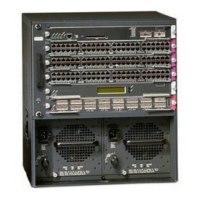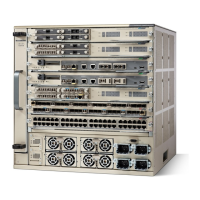8-16
Catalyst 6500 Series Switch and Cisco 7600 Series Router Firewall Services Module Configuration Guide
OL-6392-01
Chapter 8 Configuring IP Addresses, Routing, and DHCP
Configuring OSPF
To log neighbors going up or down, follow these steps:
Step 1 If you have not already done so, enter the router configuration mode for the OSPF process you want to
configure by entering the following command:
FWSM(config)# router ospf
process_id
Step 2 To configure logging fir neighbors going up or down, enter the following command:
FWSM(config-router)# log-adj-changes [detail]
This example shows how to log neighbors:
FWSM(config)# router ospf 1
FWSM(config-router)# log-adj-changes detail
Displaying OSPF Update Packet Pacing
Single context mode only
Routed firewall mode only
OSPF update packets are automatically paced so they are not sent less than 33 milliseconds apart.
Without pacing, some update packets could get lost in situations where the link is slow, a neighbor could
not receive the updates quickly enough, or the router could run out of buffer space. For example, without
pacing packets might be dropped if either of the following topologies exist:
• A fast router is connected to a slower router over a point-to-point link.
• During flooding, several neighbors send updates to a single router at the same time.
Pacing is also used between resends to increase efficiency and minimize lost retransmissions. You also
can display the LSAs waiting to be sent out an interface. The benefit of the pacing is that OSPF update
and retransmission packets are sent more efficiently.
There are no configuration tasks for this feature; it occurs automatically.
To observe OSPF packet pacing by displaying a list of LSAs waiting to be flooded over a specified
interface, enter the following command:
FWSM# show ip ospf flood-list vlan
number
Monitoring OSPF
Single context mode only
Routed firewall mode only
You can display specific statistics such as the contents of IP routing tables, caches, and databases. You
can use the information provided to determine resource utilization and solve network problems. You can
also display information about node reachability and discover the routing path that your device packets
are taking through the network.
